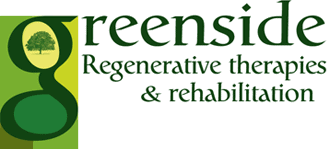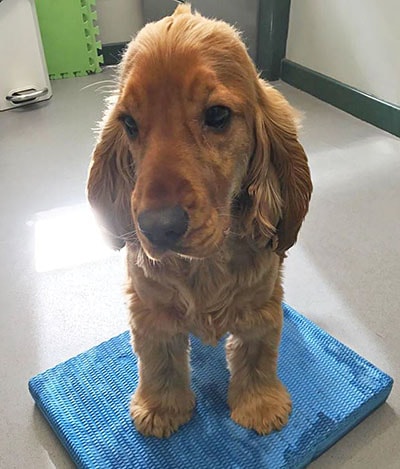
Animal Physiotherapy
Physiotherapy is defined as ‘the treatment of disease, injury, or deformity by physical methods such as massage, heat treatment and exercise rather than by drugs or surgery'.
Historically very popular in humans, physiotherapy has been applied and developed more recently in the veterinary field.
As a discipline, it works alongside veterinary intervention to further maximise results of treatment.
Physiotherapy is often beneficial in instances where the animal is unable to have medication such as non-steroidal anti-inflammatories as well as when no further medication can be prescribed.
Physiotherapy can aid in pain relief which makes it an ideal choice.
What does physiotherapy treat?
Physiotherapy can be used to treat many different conditions and the pain associated with them. Conditions that can benefit from physiotherapy include but are not limited to osteoarthritis, cruciate ligament disease, medial shoulder syndrome, hip/elbow dysplasia, lumbosacral disease, patellar luxation, and intervertebral disc disease (IVDD). Physiotherapy is also beneficial for animals' post-surgery, such as after spinal surgery or cruciate repair to aid early weight bearing and reduction of muscle loss.
How does physiotherapy work?
Physiotherapy utilises different techniques such as manual therapies, electro and Laser therapies, along with tailored home exercises.
Manual therapies
Massage is an umbrella term for many different techniques targeting pathologies. Stimulatory massage can be used to stimulate muscles after a period of disuse, using sharp and scattered strokes to trigger nerve firing and muscle activation. Effleurage massage can be used for relaxation and relief of tight muscles, using soft gentle strokes to encourage blood flow to the area. Friction massage can be used over a tendon or ligament injury to encourage correct alignment of fibres during repair.
LASER therapies
This therapy works on the principle of photo biomodulation to influence cellular respiration and energy production. Furthermore, the LASER light is warm, increasing blood flow and bringing more healing factors to the area. LASER is especially useful for pain relief, muscle tightness and relief of the symptoms of osteoarthritis, soft tissue injury, and wound healing.
Transcutaneous electromagnetic stimulation (TENS)
TENS is a common intervention in human therapy. It utilises the ‘pain gate’ theory to block transmission of pain messages to the brain. TENS provides almost instant pain relief to an area.
Neuromuscular electrical nerve stimulation (NMES)
NMES is a modality used for muscle mass increase. It manipulates the way muscles are activated in order to reduce muscle loss in areas of immobilisation as well as increasing muscle mass.
Pulsed electromagnetic energy (PEME)
PEME is a therapy used in areas of swelling, arthritis and nerve damage by the upregulation of growth factors, encouraging quicker new bone lay down and nerve firing.
Therapeutic Ultrasound (TUS)
This tool sends ultrasonic waves into the areas causing a vibration on the tissue which can help to increase the extensibility of soft tissues. Furthermore, TUS causes heat around the area and this increased blood flow can aid in reducing inflammation and pain. TUS is ideal for tendon and ligament pathologies.
Home exercise programmes
Your physiotherapist will prescribe you a programme of targeted exercises used to maximise the benefit of your pet’s rehabilitation. Cavaletti pole exercises can be used to train the animal’s gait and lengthen the stride after injury. Also, Cavaletti rails are often used for active range of motion, maintaining joint movement in a dog with joint issues. Wobble cushions are used as a core exercise. The unstable surface of the cushion requires balance and stabilisation using the animal’s abdominal muscles. Peanut ball exercises can be used to stretch the hip joint and associated musculature, as well as promoting shoulder and elbow muscle mass increase. Other exercises, such as sit-to-stands or cookie stretches can be prescribed for maintaining muscle, building up core strength, pain relief and stretching problem areas.
What to look for in a vet physio?
If your vet has suggested physiotherapy or hydrotherapy for your pet due to an injury, post-surgery rehabilitation or simply to help the physical maintenance of your senior pet, the following information will be handy!
Looking for a veterinary physiotherapist around your area can be an overwhelming task as there is a wide variety of therapist qualifications and titles out there. Moreover, the title Veterinary Physiotherapist is not protected as it is with Human Physiotherapist, making it all even more confusing. We all want the best for our pets and with this article, you will learn how to find out if the person you are contacting holds the correct title and qualification you are looking for.
Let’s take a look at what makes a Veterinary Physiotherapist:
- Veterinary physiotherapists will hold qualifications in level 6 or higher in Veterinary Physiotherapy. This equals to a BSc (hons) degree, a master's degree or post-grad.
- Vet Physios will be practicing attached to a governing body such as:
- The Institute of Registered Veterinary & Animal Physiotherapists (IRVAP)
- National Association of Veterinary Physiotherapists (NAVP)
- International Association of Veterinary Rehabilitation & Physical Therapy (IAVRPT)
- Association of Chartered Physiotherapists in Animal Therapy (ACPAT)
- Or voluntary registers such as:
- Register of Animal Musculoskeletal Practitioners (RAMP)
- Animal Health Professions' Register (AHPR)
- These organizations set a standard for the whole industry and ensure via annual renewals that these are met by each vet physio. As said, there are many credentials out there but when you contact a vet physio registered with any of these organizations you will ensure the correct qualifications are held by them, and therefore ensure the highest quality of care. It will also ensure that the physios are adequately insured.
- Many vet physios choose to be registered in multiple governing bodies, but this does not affect the level of qualification.
Now you know how to find a suitably qualified vet physiotherapist, let’s look into what makes a good vet physio:
- A good vet physio will be very nosy regarding your pet’s lifestyle. They will ask you many questions to gather as much information about your pet’s activity, performance, physical issues, medical history etc. This is so they can give you plenty of advice on how to modify some aspects of their day-to-day life, if necessary.
- They will never attempt to diagnose! That's the job of a veterinarian and a veterinarian only. Refer to our physiotherapy and hydrotherapy services to learn more about what to expect in a vet physio consult.
- Vet physios work alongside veterinarians and other paraprofessionals to be able to provide the best care in a holistic approach. This will include, for example, sending physio reports to the referring vet to keep them informed about your pet’s treatment or advise you to seek out help for a nutrition plan for weight loss, for example.
- Vet Physios will maintain high professionalism and clinical proficiency in standards of practice.
In addition to vet physios, canine hydrotherapists also have their own associations that set their own standards of practice and require specific qualifications to be able to perform their job safely. Although the profession is unregulated, meeting their entry requirements ensures a high homogenic clinical standard of practice.
The way we find a suitable hydrotherapist is similar to a vet physio! Here is how:
- Similar associations keep canine hydrotherapist registered to ensure standardized practice, including:
- National Association of Registered Canine Hydrotherapists (NARCH)
- Canine Hydrotherapy Association (CHA)
- Institute of Canine Hydrotherapists (ICH, an IRVAP sub-group).
- There are many courses available to achieve the title of canine hydrotherapist, therefore note when looking for a suitable hydrotherapist that their qualification is recognized by one of the three associations. Diplomas or Certificates in Level 3 or 4 Canine or small animal hydrotherapy are most common.
- To find a hydrotherapy center approved by these associations, refer to their websites and type your area’s postcode to find the nearest one to you. These centers will ensure the standard code of practice is followed and all their hydrotherapists are correctly qualified.
Extracorporeal Shockwave Therapy for Musculoskeletal Pathologies
Physiotherapy and Regenerative Medicine
Physiotherapy is often used as a conjunctive therapy alongside regenerative medicine in order to maximise the benefits of stem cell therapy or platelet-rich-plasma. As well as being used for pain in relation to their condition, physiotherapy works to reduce the effects of immobilisation; minimising muscle loss throughout the body and aids in muscle strengthening in these areas.
Furthermore, it has been found that some electro and LASER therapies offered at Greenside, can help energise the stem cells after they have been implanted, reinforcing their use throughout the Stem Cell therapy process. It is commonly recommended for the animal to have six LASER sessions post implantation of stem cells.
Veterinary physiotherapists work under veterinary referral, meaning that a vet must refer the animal for physiotherapy. This can be achieved by completing one of our referral forms, which can be found and submitted online or sent to the veterinary practice directly. They must be completed and signed by the animal’s existing veterinary practice. Direct enquiries will also be responded to promptly.
What to expect?
Prior to the initial consultation your physiotherapist will evaluate your pet’s previous clinical history, including vet reports and any radiographs. During the initial physiotherapy consultation, the physiotherapist will conduct a full static assessment, feeling through all the muscles and joints, followed by a dynamic assessment of how the animal walks, looking at stride lengths and joint flexion. The physiotherapist will then talk through results with the owner and perform an appropriate first treatment. A bespoke home exercise programme will then be demonstrated and prescribed involving exercises to be completed at home to further benefit the animal.
Follow up sessions will also involve full static and dynamic assessments. The physiotherapist will perform another treatment on the animal and change the home exercise programme to suit the animal’s progress, whether it be adding more difficult exercises or reducing the workload. Electro or Laser therapies may be used in conjunction with manual therapies.
Many insurance companies will cover physiotherapy. Refer to your policy terms and conditions for more information.
Extracorporeal Shockwave Therapy for Musculoskeletal Pathologies



